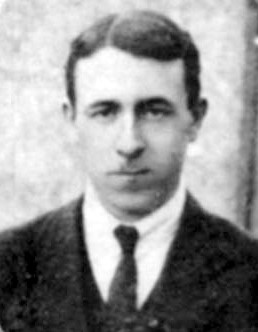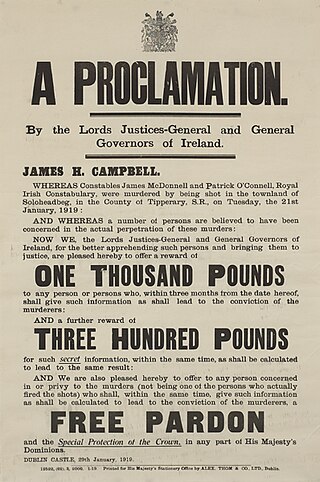
County Tipperary is a county in Ireland. It is in the province of Munster and the Southern Region. The county is named after the town of Tipperary, and was established in the early 13th century, shortly after the Norman invasion of Ireland. It is Ireland's largest inland county and shares a border with eight counties, more than any other. The population of the county was 167,895 at the 2022 census. The largest towns are Clonmel, Nenagh and Thurles.

Clonmel is the county town and largest settlement of County Tipperary, Ireland. The town is noted in Irish history for its resistance to the Cromwellian army which sacked the towns of Drogheda and Wexford. With the exception of the townland of Suir Island, most of the borough is situated in the civil parish of "St Mary's" which is part of the ancient barony of Iffa and Offa East.

Daniel Breen was a volunteer in the Irish Republican Army during the Irish War of Independence and the Irish Civil War. In later years he was a Fianna Fáil politician.

Séumas Robinson was an Irish republican and politician.
The Tipperary Senior Football Championship is an annual Gaelic Athletic Association club competition between the top Gaelic football clubs in Tipperary. The winners of the Tipperary Championship qualify to represent their county in the Munster Senior Club Football Championship, the winners of which advance to the All-Ireland Senior Club Football Championship.

Seán Allis Treacy was one of the leaders of the Third Tipperary Brigade of the IRA during the Irish War of Independence and one of a small group whose actions initiated that conflict in 1919. He was killed in October 1920, on Talbot Street in Dublin in a shootout with British troops during an aborted British Secret Service surveillance operation.

Seán Hogan was one of the leaders of the 3rd Tipperary Brigade of the Irish Republican Army during the War of Independence.
Sologheadbeg or Soloheadbeg is a townland and civil parish in County Tipperary, Ireland, lying northwest of Tipperary town.

Edmond Foley, sometimes known as Edmund or Edward, was a member of the Irish Republican Army (IRA) who was hanged in Mountjoy Prison on 7 June 1921. Together with nine other men executed by hanging during the War of Independence, he was one of The Forgotten Ten.

The 3rd Tipperary Brigade was one of the most active of approximately 80 such units that constituted the IRA during the Irish War of Independence. The brigade was based in southern Tipperary and conducted its activities mainly in mid-Munster.

Denis Lacey was an Irish Republican Army officer during the Irish War of Independence and anti-Treaty IRA officer during the Irish Civil War.

Knocklong is a small village in County Limerick, Ireland. It is 29 km south-east of Limerick city, on the main Limerick to Mitchelstown to Cork road. The population was 256 at the 2016 census. The village is in a civil parish of the same name.

Richard Farrelly was an Irish songwriter, policeman and poet, composer of "The Isle of Innisfree", the song for which he is best remembered. His parents were publicans and when Farrelly was twenty-three he left Kells, County Meath for Dublin to join the Irish Police Force. He served in various Garda stations throughout his thirty-eight-year career, ending up in the Central Detective Unit (CDU) Dublin Castle as the pay Sergeant up to his retirement. At heart Farrelly was very much a songwriter and poet. He was a private, modest and shy man who wrote over two hundred songs and poems during his lifetime. He married Anne Lowry from Headford, County Galway in 1955 and the couple had five children. His two sons Dick and Gerard are professional musicians.
The Glen of Aherlow is a traditional Irish song which originated as a ballad written by Irish republican Charles Joseph Kickham (1828–1882). It was first printed in The Kilkenny Journal, Kilkenny, on 7 October 1857, the writer using the pseudonym “Darby Ryan, Junior.”
"The Galtee Mountain Boy" is an Irish folk ballad, originally written by Patsy O'Halloran. Christy Moore added a fourth verse to O'Halloran's original three; this is the version that is most commonly performed.

The Soloheadbeg ambush took place on 21 January 1919, when members of the Irish Volunteers ambushed Royal Irish Constabulary (RIC) officers who were escorting a consignment of gelignite explosives at Soloheadbeg, County Tipperary. Two RIC officers were killed and their weapons and the explosives were stolen. The Volunteers acted on their own initiative and had not sought authorisation for their action. As it happened on the same day that the revolutionary Irish parliament first met and declared Ireland's independence, it is often seen as the first engagement of the Irish War of Independence.
On 13 May 1919, a captured Irish Republican Army (IRA) member, Seán Hogan, was rescued from a train by his comrades while being guarded by four armed Royal Irish Constabulary (RIC) officers. Two of the RIC officers were killed and several IRA volunteers were wounded. The rescue took place on Hogan's 18th birthday, while the Cork-bound train stopped at Knocklong station in County Limerick. It was undertaken by three of Hogan's comrades from the 3rd Tipperary Brigade of the IRA and five members of the Galtee Battalion of the East Limerick Brigade. Hogan was one of the most wanted men in Ireland at the time of his rescue, due to his role in the Soloheadbeg ambush and would almost certainly have been executed.
The 2015 Tipperary Senior Football Championship was the main club football championship that took place in County Tipperary. Loughmore-Castleiney were the defending champions after winning their 13th title in 2014, but lost in the quarter-finals to Clonmel Commercials.










